Archbishop John Mark Gannon
If Bishops Mullen and Fitzmaurice had the task of sowing seeds in the Diocese of Erie, Bishop John Mark Gannon heeded the call to harvest them. Much was in bloom in Erie during Bishop Gannon’s tenure—an unprecedented 46 years of service. He cared deeply for his home diocese, and consistently worked hard to establish institutions and programs that are still ministering to the Erie community today.
Erie’s first “native son” bishop, Bishop Gannon was one of the youngest bishops in the United States at the time of his appointment in 1920. Bishop Gannon’s father, Thomas, was a drummer boy in the Civil War, and his mother, Julia, lived with her son until the end of her life.
The precise history is unclear, but legend has it, Father Pino says, that Bishop Gannon was offered the appointment to serve as archbishop of Philadelphia, but refused it. He was rumored to have been offered the same position in New York, but refused that, too.
“He loved Erie,” Father Pino says. “He had a good thing going here.”
Bishop Gannon reverently delighted in the pomp and circumstance of liturgical celebrations and certainly enjoyed the extras that came along with being named an archbishop: the extra t wo tassels on his coat of arms, a longer cape and the title “your grace” instead of “your excellency.” Even amid all the formality, Bishop Gannon was quick to interact with people in a personal and meaningful way. An old newspaper photo captured a moment with the bishop playing “stick ’em up” with a barefoot boy sporting two toy six-shooters and a cowboy hat. The bishop, meanwhile, was in full liturgical garb for ordination.
wo tassels on his coat of arms, a longer cape and the title “your grace” instead of “your excellency.” Even amid all the formality, Bishop Gannon was quick to interact with people in a personal and meaningful way. An old newspaper photo captured a moment with the bishop playing “stick ’em up” with a barefoot boy sporting two toy six-shooters and a cowboy hat. The bishop, meanwhile, was in full liturgical garb for ordination.
The Great Depression settled over the nation in the 1930s, and Erie was not immune. When hobos would throw pebbles at the rectory window, Bishop Gannon would lend them a hand, tossing them money.
Bishop Gannon had a passion for education. He established Cathedral College—later to become Gannon University—as well as the regional Catholic high schools and St. Mark Seminary. In response to the persecution of Catholics in Mexico, Bishop Gannon helped establish Montezuma Seminary in New Mexico to train young Mexican men who were unable to study in their home country.
He sent art professors from the high schools and colleges to study in Europe so they could return and help beautify their campuses. He worked hard to support the Sisters of St. Joseph, the Sisters of Mercy and the Benedictines in their ministries and welcomed the Carmelite sisters to the diocese. In total, Bishop Gannon helped institute 28 parishes, 49 churches, seven rectories and 12 convents and played a critical role in the opening of many hospitals and ministries including Harborcreek Training School for Boys, Gannondale for Girls and the Erie Day Nursery.
Bishop Gannon was given the unique and rarely bestowed honor of “archbishop ad personam,” Father Pino explains. Even though Erie was not an archdiocese—the typical requirement for a bishop to receive the archbishop title—the “ad personam” distinction is a personal title given for great service to the Catholic Church.
Toward the end of his life, when he was in his 80s, Vatican II began and Archbishop Gannon attended a session with a young priest from Buffalo named Father Donald Trautman. While celebrating one of the first Masses said in English at St. Mark Seminary, Father Pino said, one of the priests looked over at Archbishop Gannon and noticed he was crying. Naturally, he asked the shepherd what was wrong.
“I’ve never heard my name spoken in English in the canon before,” Archbishop Gannon replied, tears in his eyes.
Even though he was in his twilight years as a bishop during the sessions, Archbishop Gannon embraced the changes that came with Vatican II and was on fire with what it would mean for the future of the church.
“The man who loved pomp and circumstance was very open to its renewal,” Father Pino said. Archbishop Gannon retired at 90 and died two years later on Sept. 5, 1968.


